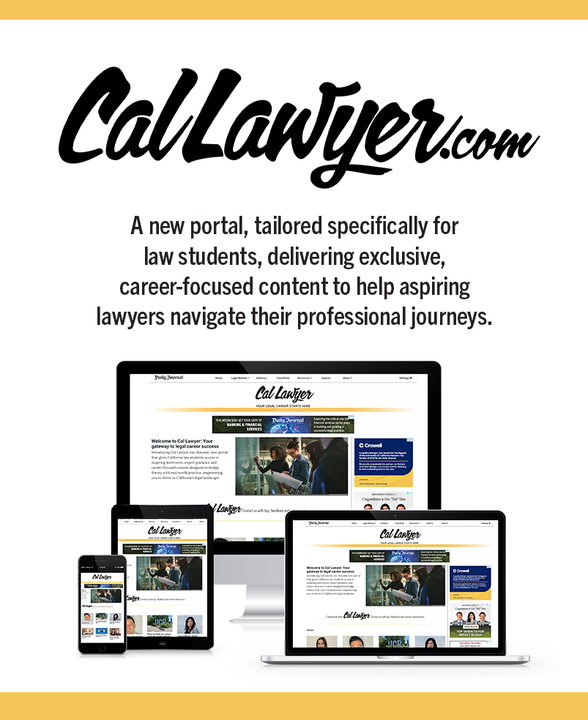Rebuilding LA:
The Daily Journal's fire coverage portal

MCLE
Canadian Space Agency
What does 'making canceling a subscription as simple as signing up' mean for companies?
The White House and FTC are pushing a 'click to cancel' ...
By Alejandro Moreno, Skylar StoudtNew regulations to cement conservation as a 'California Way of Life'
Californians can expect further water conservation measur...
By Samuel Johnson, Wendy Y. WangToday's News
Judges and Judiciary
California judges in line for 2.6% pay bump
By Malcolm Maclachlan
AB 181, which grants judges and other state workers a raise, is headed to Gov. Gavin Newsom's desk.
Judges and Judiciary
Even if Harris wins, Democrats likely to find judge confirmations harder
By Craig Anderson
Vice President Kamala Harris might have more constraints even if she prevails in the election, given the distinct possibility that Republicans will retake co...
Intellectual Property
MGA faces 3rd trial to defend doll against NIL claims
By Sunidhi Sridhar
Despite securing a win last year in federal court in Santa Ana, MGA Entertainment failed to convince U.S. District Judge James V. Selna that the jury verdict...
Government
State to pay $350K to settle sex harassment case against Treasurer Fiona Ma
By Malcolm Maclachlan
The notice of settlement came days after attorneys with Gavrilov & Brooks were substituted in to represent Ma against the claims by an official the treas...
Judges and Judiciary
Two new commissioners appointed to LA court!
By Douglas Saunders Sr.
The appointments will fill vacancies left open due to Tiffany W. Tai's appointment as a judge and the death of Commissioner Frank Chen.
5/6 @ 5PM test
Columns
Insurance, Torts/Personal Injury
Recovering emotional distress damages for breach of an insurance contract
By Michael L. Cohen
California case law establishes that, in some situations, insured individuals may be entitled to emotional distress damages fo...
Effectively targeting key instructions and discussing them with the jury during your closing argument can significantly influe...
Ethics/Professional Responsibility, Law Practice
Can't we all just get along? Fee agreements, fee splitting & disputes
By Jean Cha
Even with detailed fee agreements, payment disputes and communication issues can arise, so implementing best practice billing ...
Verdicts & Settlements
| Wage and Hour | Hilario E. Ramirez, on beha... | $340,000 |
| Sexual Discrimination | California Civil Rights Dep... | $15,000,000 |
| Auto v. Truck | Anthony Wooten v. Western E... | $2,757,114 |
| Dangerous Condition of Public Property | Helen Mattson v. City and C... | $190,000 |
| Dangerous Condition of Public Property | Jane Swigart v. San Francis... | $150,000 |
| Malpractice | Jean Kim v. Pets' Rx Inc. d... | Defense |
| Information Practices Act | The People of the State of... | $6,750,000 |
| Wage and Hour | Victor Acosta, individually... | $2,750,000 |
| Wage and Hour | Joy Macopson, individually ... | $2,235,000 |
| Excessive Force | Jeremiah Keilan Jenkins, in... | $875,000 |
On the Move
Daily Journal Corp.
Billy Bob joined Daily Journal Corp. as an associate.
test
Details
Daily Journal Corp. has 1 attorney in Culver City. Among the law firm’s key practice areas are Test. The firm’s website is www.site.com
Featured Content
JAMS neutral reflects on her career, what inspires her and what brought her back to JAMS after 20 years on the bench
Alternative Dispute Resolution
Alternative Dispute Resolution
Community News
Bram Alden was most recently chief of the Criminal Appeals section at the U.S. attorney's office for the Central District of C...
Podcasts
In this compelling season premiere of In the Public Interest, three distinguished WilmerHale experts dive into the comp...
Daily Appellate Report
Criminal Law and Procedure
People v. Mejia
Police use of multiple photographic lineups where witness was uncertain about her initial identification was reasonable and did not offend due process.
Attorneys
Simers v. Los Angeles Times Communications LLC
Despite plaintiff's counsel's misconduct leading to the need for another trial, trial court did not abuse its discretion in awarding her attorney's fees.
Anti-SLAPP, Employment Law
Modification: Taylor v. Tesla, Inc.
Despite pending parallel litigation, refusal to respond to employee record requests under the Labor Code was not protected conduct subject to the provisions of the anti-SLAPP statute.
Bankruptcy
In re: US v. Warfield
Pro rata allocation of proceeds that were insufficient to pay tax and penalty portions of tax lien including both where trustee avoided penalty portion was inconsistent with the Bankruptc...
Criminal Law and Procedure
Garraway v. Ciufo
Absent a denial of qualified immunity, district court orders extending *Bivens* are not immediately appealable under the collateral order doctrine.









